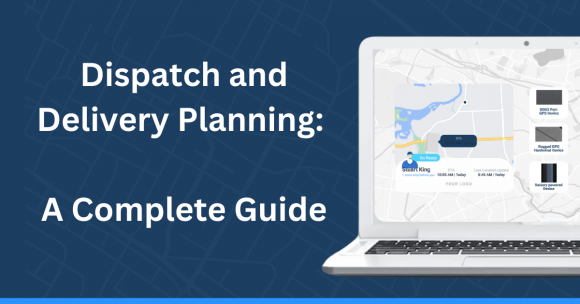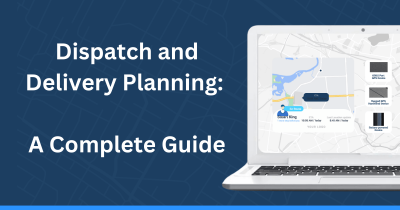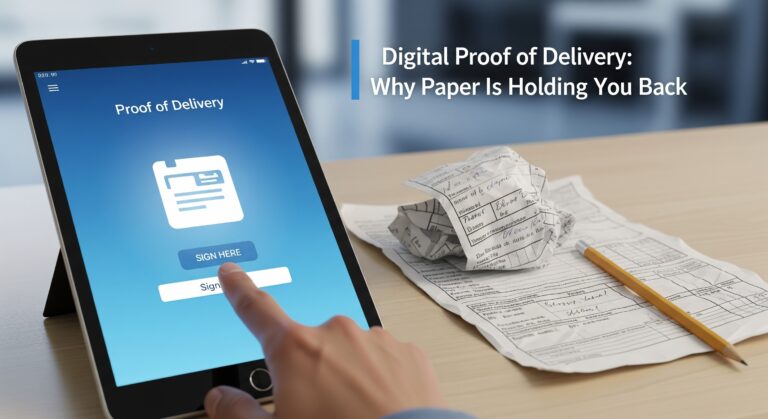Dispatch and delivery planning can easily be described as the backbone of successful logistics and transportation companies.
For businesses, it’s not just about getting products from point A to B anymore. No. It’s about doing it in a cost-effective way, getting it done on time, and in a way that keeps customers happy.
In this guide, we’ll break down the core principles of dispatch and delivery planning. We’ll also look at the benefits, and provide actionable insights for businesses.
Let’s dive in.
What Is Dispatch and Delivery Planning?
Dispatch and delivery planning is the process of organizing and scheduling deliveries in the most efficient way possible.
It includes assigning drivers, selecting routes, and making sure deliveries are timely and meet customer expectations.
With modern tools like delivery management software, businesses can easily streamline these tasks while also minimizing errors and saving valuable time.
Thus, businesses that invest in robust dispatch and delivery planning not only stay competitive but also future-proof their operations.
Why You Need Dispatch and Delivery Planning
The age-old adage goes: those who fail to plan, plan to fail. And it’s no different when it comes to business.
Businesses that fail to plan effectively risk falling behind.
Dispatch and delivery planning guarantees that your processes run smoothly. This improves both customer satisfaction and overall profitability.
But don’t just take our word for it—recent data emphasizes backs it up!
A 2024 report from Research and Markets shows how the global logistics software market – which includes dispatch planning tools – is expected to grow at a compound annual growth rate (CAGR) of 10.3% through 2028.
This growth is fueled by increasing demand for real-time tracking, route optimization, and automation across industries.

The industry isn’t stagnant. If anything, it’s constantly evolving. In 2020, 24% of online shoppers in the US wanted same-day delivery for their web-based purchases, according to Statista.
Just a year later, that figure increased to 36%. In 2024, Capital One data shows that 80% of consumers now expect same-day delivery. And 51% of online retailers in the US now offer same-day delivery.
The demand for faster and more efficient services shows how critical dispatch and delivery planning is when it comes to meeting customer expectations.
Without a solid plan in place, businesses risk falling short in an increasingly competitive market.
Benefits of Dispatch and Delivery Planning
It’s important to understand how well-organized dispatch and delivery planning can take a business to the next level of efficiency.
By addressing common bottlenecks and ensuring a smoother workflow, this process paves the way for increased efficiency and better customer relationships.
Here are some of the benefits.
1. Improved Operational Efficiency
Planning ahead ensures that deliveries are timely and efficient. Drivers spend less time idling in traffic or retracing their routes.
Dispatch systems also provide tools for real-time adjustments, which means businesses can respond to last-minute changes without chaos. No more unexpected delays due to weather or traffic.
When done right, this sort of planning translates into happier employees, as drivers can stick to clear schedules without the stress of unnecessary backtracking.
And a happy driver delivering items on time, in turn makes customers happy.
2. Enhanced Customer Satisfaction
Reliability is everything in delivery.
Customers who receive accurate ETAs, real-time tracking links, and timely deliveries are far more likely to stick with your business.

Additionally, dispatch planning tools guarantee proactive communication. Customers are informed immediately if there’s a delay, and this transparency will make them trust your brand.
3. Cost Savings
Every mile and every minute on the road costs money.
Route optimization tools in dispatch planning reduce unnecessary travel, saving on fuel and minimizing vehicle wear and tear.
Over time, these small savings add up, significantly improving your bottom line.
For businesses with larger fleets, automated dispatching also reduces those pesky administrative costs by getting rid of manual, time-costly scheduling processes.
4. Reduced Errors
Despite being a terribly tedious process, manual planning leaves room for mistakes: wrong addresses, incorrect scheduling, or missed deliveries.
But automation, on the other hand, lowers these risks by providing drivers with accurate and up-to-date delivery details.
This leads to fewer failed deliveries and less time spent resolving customer complaints.
Key Features of Effective Dispatch and Delivery Planning
Effective dispatch and delivery planning is not just about getting goods from one place to another.
It’s about using the right tools and strategies to make every step of the process as seamless as possible.
Let’s take a closer look at the features that make this possible.
1. Route Optimization
Route optimization tools are more than just time-savers; they are essential for minimizing costs.

By analyzing real-time traffic, weather conditions, and delivery priorities, these tools ensure that drivers take the shortest, safest, and most efficient routes.
Advanced systems can also suggest alternative routes in real-time to avoid potential delays, keeping deliveries on schedule.
GO DEEPER: Route optimization software explained
2. Real-Time Tracking
Real-time tracking bridges the gap between businesses and their customers.
Managers can monitor every delivery, ensuring that drivers stick to schedules, while customers appreciate the transparency of knowing where their packages are at any moment.
Tracking also empowers businesses to address issues as they arise, such as rerouting drivers to avoid traffic or immediately responding to customer concerns.
3. Dynamic Re-Routing
Unpredictable events like sudden road closures or severe weather can disrupt even the best-laid plans.
Dynamic re-routing tools allow businesses to pivot in real time, keeping deliveries on track despite challenges.
By adapting to these disruptions on the fly, businesses can maintain customer trust while minimizing delivery delays.
4. Driver Assignment
Effective driver assignment means deliveries are matched with the most appropriate drivers.
To get this delicate balance just right, factors like proximity, vehicle type, and available capacity must be considered.
ALSO READ: What is driver application software? Your complete guide
Smart assignments also reduce driver stress by ensuring that workloads are distributed fairly across the fleet.
This maximizes efficiency and minimizes downtime.
5. Proof of Delivery (POD)
Proof of Delivery tools go beyond just confirming that a package was delivered.
They provide irrefutable evidence, such as electronic signatures, timestamped photos, or GPS data, which can be crucial for resolving disputes quickly and professionally.
POD systems also enhance accountability, giving customers peace of mind and ensuring businesses maintain a strong reputation for reliability.
Challenges in Dispatch and Delivery Planning
While dispatch and delivery planning can significantly enhance logistics operations, it does come with its fair share of challenges unfortunately.
But fret now.
Addressing these obstacles head-on can help businesses maintain a competitive edge and deliver exceptional service.
1. Unpredictable Delays
No one can predict every traffic jam or sudden road closure.
However, tools like Locate2u use real-time data to keep businesses one step ahead.
By factoring in live traffic updates and weather conditions, these systems help reroute drivers to avoid delays.
Even with proactive planning, the ability to communicate delays transparently to customers can turn potential dissatisfaction into understanding.
2. Driver Shortages
The logistics industry continues to face driver shortages, making it harder to meet growing delivery demands.
Automated scheduling tools can help businesses maximize the efficiency of their existing teams. This also reduces downtime and ensures resources are used effectively.
Long-term solutions might also include training and incentivizing new drivers to join the workforce.
ALSO READ: How driver rating software can improve your logistics operations
3. Data Overload
Managing delivery data for multiple drivers and routes can be overwhelming without the right systems!
Luckily, modern dispatch tools can organize this information into easy-to-read dashboards. This will help logistics managers and their teams make quick, informed decisions.
Data overload often leads to decision fatigue, but user-friendly software can simplify even the most complex delivery operations.
Locate2u Case Study: SuperPharmacy
What better way to understand the impact of dispatch and delivery planning than to look at a real-world example.
The problem: SuperPharmacy, a leading delivery service, struggled with manual route planning that consumed valuable time and left room for errors.
The solution: Implementing Locate2u’s route optimization and dispatch planning tools took care of that problem. The system allowed dynamic re-routing, real-time tracking, and proof of delivery.
The results: SuperPharmacy saved hundreds of hours annually, improved delivery accuracy, and increased customer satisfaction with faster, more reliable service.
How to Choose Dispatch and Delivery Planning Tools
Finding the right tools for dispatch and delivery planning can feel overwhelming. There are after all so many options on the market!
The key is to focus on the features and capabilities that align with your business goals and challenges.
- Assess your business needs
Start by evaluating the size of your fleet, delivery volume, and specific challenges.
- Look for scalability
Choose a tool that can grow with your business, like Locate2u, which is designed for small and medium enterprises but can scale for larger operations.
- Prioritize real-time capabilities
Real-time tracking, dynamic updates, and instant notifications should be non-negotiable features.
- Check integration options
Ensure the software integrates seamlessly with existing systems like CRM or ERP for streamlined operations.
Future Trends in Dispatch and Delivery Planning
Staying ahead means understanding where the industry is headed.
1. AI-driven route optimization
Artificial intelligence will be better at predicting delays and adjusting routes proactively.
2. Sustainability in logistics
With a growing focus on eco-friendly practices, expect more tools designed to reduce carbon footprints through efficient route planning.
3. IoT Integration
The Internet of Things (IoT) will enable smarter delivery tracking with real-time updates on vehicle performance, package conditions, and more.
FAQs on Dispatch and Delivery Planning
1. What is dispatch and delivery planning software?
It’s a tool that automates and optimizes the scheduling, routing, and monitoring of deliveries to improve efficiency and accuracy.
2. How does route optimization save costs?
By calculating the shortest and fastest routes, route optimization reduces fuel consumption, labor hours, and vehicle wear and tear.
3. Can dispatch software integrate with my CRM system?
Yes, many modern solutions like Locate2u offer integration options to connect with CRM, ERP, or other business tools.
Final Takeaways on Dispatch and Delivery Planning
Effective dispatch and delivery planning isn’t just a luxury.
As industries continue to adapt to consumer behavior, these tools become a necessity for businesses aiming to stay competitive.
By addressing common challenges, leveraging modern tools, and prioritizing customer satisfaction, your business will be one step ahead of the competition.
About the author
Cheryl has contributed to various international publications, with a fervor for data and technology. She explores the intersection of emerging tech trends with logistics, focusing on how digital innovations are reshaping industries on a global scale. When she's not dissecting the latest developments in AI-driven innovation and digital solutions, Cheryl can be found gaming, kickboxing, or navigating the novel niches of consumer gadgetry.









